
Reservation booth:+86(0)21-3114 8748
Visit/media contact:+8613601815988
QQ:2463282767
email:artsexpo@sgexpo.cn
On May 17, the General Office of the Guangzhou Municipal Government issued the "Guangzhou Comprehensive Three-dimensional Transportation Network Plan (2023-2035)" (hereinafter referred to as the "Plan").
According to the plan, Guangzhou is planning ahead of time with the layout of high-speed maglev channels and the construction of experimental lines between other megacities, reserving two channels of Beijing-Hong Kong-Macao high-speed maglev and Shanghai-Shenzhen-Guangzhou high-speed maglev; Combined with the T3 terminal of Guangzhou Baiyun International Airport, the new T3 high-speed rail station of Baiyun International Airport will be built, and the T4 terminal and special track of Guangzhou North Railway Station will be planned and reserved; In terms of urban rail transit, we will start the fourth phase of urban rail transit construction plan for approval, and study the east extension of urban rail line 22.
In addition, in the face of the mismatch between the level of transportation development in Nansha and the city's positioning, as well as the tight constraints on land, environment and capital, the Plan emphasizes the strengthening of the Nansha Bay District's transportation center function and the promotion of high-standard coordination of comprehensive transportation through overall planning and integration.
From the overall point of view of the "Planning" -
The plan proposes that by 2035, Guangzhou will achieve a "12312" travel traffic circle, that is, it will be accessible to major cities in the Guangdong-Hong Kong-Macao Greater Bay Area within 1 hour, with eastern and western Guangdong and northern Guangdong within 2 hours, with major cities in China and Southeast Asia within 3 hours, and with major cities around the world within about 12 hours; As well as the realization of the "123" fast cargo flow circle, that is, 1 day delivery in domestic cities, 2 days in major cities in Southeast Asia, and 3 days in major cities around the world.
By 2035, the total scale of the city's comprehensive three-dimensional transportation network is about 20,000 kilometers, including about 2,300 kilometers of tracks, about 15,000 kilometers of roads, about 1,500 kilometers of waterways, about 840 kilometers of oil and gas pipelines, 1 civil transportation airport, and 7 major port areas. There are 21 major railway hubs, forming an efficient highway hub cluster and a multi-point supported postal express hub cluster.
According to the urban space, industrial layout and transportation resources, the comprehensive transportation hub is divided into four levels of classification for international, national, regional and urban service scope, and 5 international comprehensive transportation hubs, 17 national comprehensive transportation hubs and a number of regional and urban hubs are built.
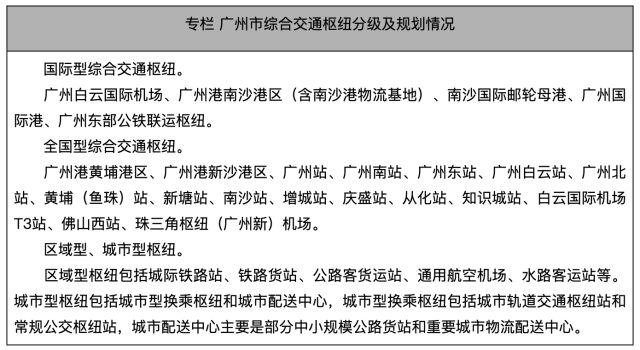
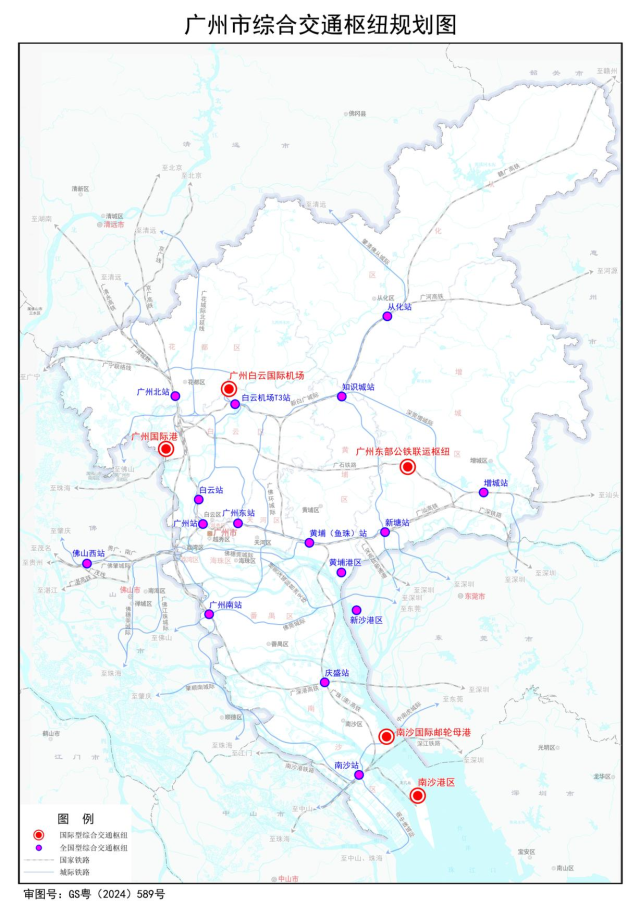
From the point of view of the improvement of the aviation hub -
In addition to the Guangzhou Baiyun International Airport hub energy level upgrade, the "planning" should not only speed up the construction of the Pearl River Delta hub (Guangzhou new) airport, promote the division of labor with Guangzhou Baiyun International Airport, but also in Panyu, Zengcheng, Nansha, Conghua, Huangpu planning and construction of five general airports, overall promotion of helicopter take-off and landing point layout, and gradually improve the planning and construction of supporting facilities such as flight service stations, enhance the ability of low-altitude flight service support system, and build an urban low-altitude flight service network.
The accessibility of the airport requires both abundant routes and the support of the evacuation system.
To this end, the plan proposes to strengthen the connection between Guangzhou Baiyun International Airport and national railways, intercity railways, urban railways, and high-speed (fast) roads. Combined with the new Baiyun International Airport T3 high-speed rail station in Guangzhou Baiyun International Airport T3 terminal, it is planned to reserve the T4 terminal and special track of Guangzhou North Railway Station, plan to introduce "6 high-speed railways + 5 intercity + 2 subways + 1 special track", build a high-speed road network of "six horizontal and seven vertical", renovate and expand Huizhao Expressway and Airport Expressway, and realize 30-minute access between the airport and the central city of Guangzhou, and 1-hour access to major cities in the Greater Bay Area. It is 3 hours away from neighboring provincial capitals.
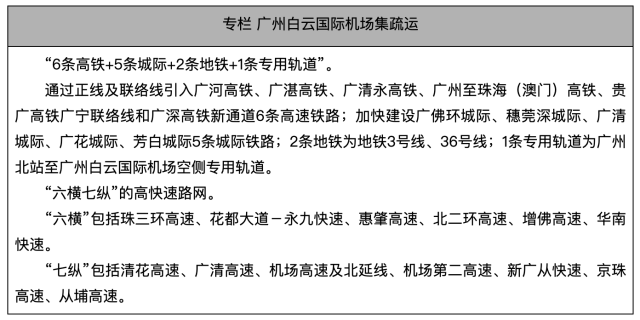
From the perspective of the layout of the railway hub -
The railway passenger hub will assume the function of supporting and leading the expansion of urban space and the optimization of industrial layout.
The layout is based on the pattern of "five main and four auxiliary multi-nodes", the "five mains" are Guangzhou Station, Guangzhou East Station, Guangzhou South Station, Guangzhou Baiyun Station, Foshan West Station, and the "four auxiliaries" are Guangzhou North Station, Huangpu (Yuzhu) Station, Xintang Station, and Nansha Station. The plan aims to achieve 83% coverage of high-speed railway nodes at the district level by 2025 and 100% by 2035.
As the main mode of transportation for Guangzhou and even Guangdong, Guangzhou will promote the formation of ten high-speed rail corridors out of the province.
In view of the existing problems that the northbound passage to the Beijing-Tianjin-Hebei region tends to be saturated, the northwest-to-Chengdu-Chongqing urban agglomeration railway channel is single, and the eastward high-standard direct high-speed rail channel with the Yangtze River Delta region has not yet been completed, the "Planning" proposes to add the Guangqing-Yong high-speed railway and the Guizhou-Guangzhou high-speed railway Guangning connection line to improve the connection efficiency from Guangzhou to Chengdu-Chongqing; The Guanghe high-speed railway will be added, and the high-speed rail corridor from Guangzhou to the Yangtze River Delta will be added; actively plan to expand the high-speed rail corridor from Guangzhou to Beijing-Tianjin-Hebei; speed up the construction of the Guangzhou-Zhanjiang high-speed railway, and strengthen the connection between Guangzhou and central Yunnan; New high-speed rail corridors from Guangzhou to Zhuhai (Macao) and Guangzhou-Shenzhen high-speed rail have been added to strengthen the connection between Guangzhou and Zhuhai, Macao and Shenzhen and Hong Kong.
In addition, Guangzhou will plan in advance the layout of the high-speed maglev channel between Guangzhou and other megacities and the construction of the experimental line, reserve the Beijing-Hong Kong-Macao high-speed maglev and the Shanghai-Shenzhen-Guangzhou high-speed maglev, and build a high-speed corridor from Guangzhou to Beijing-Tianjin-Hebei, the Yangtze River Delta and the eastern coastal areas. It can be reached within 1 hour with the city centers of the Greater Bay Area, 2 hours with cities in the province, 3 hours with neighboring provincial capitals, and 5~8 hours with major cities of national urban agglomerations.
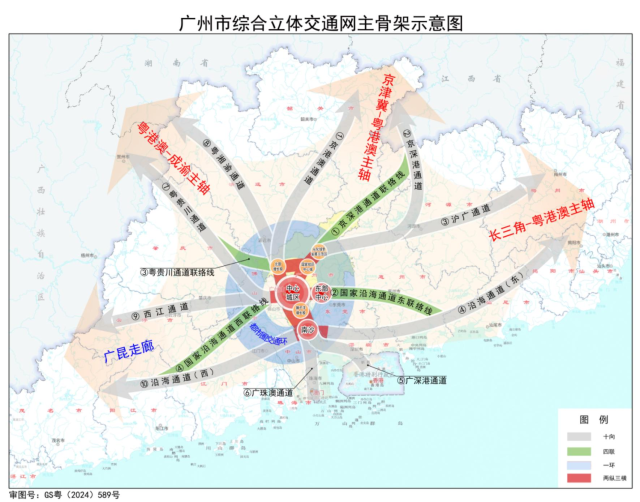
From the perspective of rail transit construction in the metropolitan area——
Guangzhou will build a multi-network integrated rail network, promote the implementation of the fourth phase of the urban rail transit construction planning project, and strive to build a 1,000-kilometer urban rail network by 2035.
The important projects of metropolitan rail transit network connectivity mentioned in the "Planning" include: promoting the planning and construction of intercity railways such as Xinbaiguang Intercity, Foguan Intercity, Guangzhou-Foshan Intercity, Guanghua Intercity, Fangbai Intercity, Guangzhou-Dongguan-Shenzhen Intercity Pazhou Branch, Guangqing Intercity (Phase II), Nansha to Zhuhai (Zhongshan) Intercity, Fozhou-Dongguan Intercity, etc.; Implement subway lines under construction such as Metro Line 10, Line 11, Line 12, and Line 8 North Extension Branch, and start the fourth phase of urban rail transit construction planning for approval, study the east extension of urban rail line 22, and build the Guangzhou metropolitan area on the track.
From the perspective of high-speed roads and urban road development -
By 2035, the total mileage of the city's backbone road network will reach 1,500 kilometers, and the cities in the Greater Bay Area can be reached in 2 hours, cities in the province in 5 hours, and central cities in surrounding provinces (regions) in 8 hours.
In the construction of cross-river and cross-sea passages, the construction of the Shiziyang Passage and the South-Central Expressway, the construction of the Lianhuashan Passage will be promoted, and the Shayuzhou Tunnel and the Hualong-West Development Zone will be actively planned. Promote the expansion and transformation of high-speed congested road sections, implement the airport expressway, the Beijing-Hong Kong-Macao Expressway, the section from Fogang to Guangzhou in Qingyuan, Guangzhou, and the North Second Ring Expressway, and strengthen the expansion and management of easy-to-block and slow-moving toll stations. Encrypt the interconnection channels with surrounding cities, promote Foqing Expressway (Guangzhou section), Huizhao Expressway (Baiyun to Sanshui section), Qinghua Expressway and other channels, and strengthen Guangzhou's radiation capacity to the east, west and north of Guangdong.
The planning of the urban trunk road network focuses on improving the interconnection level of the road network between the central urban area and the eastern and southern regions of Guangzhou, and accelerating the construction of roads such as the Huangpu-Nansha East Expressway and Linjiang Avenue. In the central urban area, two north-south expressways will be studied and constructed, namely Shihua Road - Shayuzhou Tunnel - Nanda Trunk Road - Huangpu to Nansha East Expressway and Zhuji Road - Yuzhu Tunnel - Xinhua Expressway, so as to improve the north-south diversion capacity of the southeast of the Ring Expressway.
In the urban border area, the focus is on strengthening the effective connection of road traffic in Guangzhou-Foshan, Guangzhou-Dongguan, Guanghui, Guangqing, and Guangzhou-Zhong. Promote projects such as the Guangzhou-Foshan Bridge System Project (Phase I), the Agarwood Bridge, the Dongjiang Passage from the West District of the Development Zone to Machong, and the reconstruction project of the Jianglong Bridge.

Strengthening the function of the transportation center of Nansha Bay District is one of the key points of the plan
The plan proposes to build a half-hour traffic circle from the central area of Nansha to the central areas of major cities in the Greater Bay Area, key platforms and major transportation hubs, and help build a 100-kilometer "golden inner bay" around the Pearl River Estuary.
Specifically, we will strive for the extension of the Hong Kong-Shenzhen Western Railway to Nansha Station and establish a direct transportation link between the Nansha hub and Hong Kong; Study the upgrading of Zhongnanhu Intercity and Zhaoshun South Intercity to the eastward extension of high-speed rail and urban rail Line 22 to strengthen the rapid connection with the east and west banks of the Pearl River; Speed up the construction of the cross-river passage connecting Nansha, and plan the Suishen channel.
How to strengthen the connection between Nansha and other groups in Guangzhou? The plan proposes to improve the rapid and direct transportation system of Nansha through the city, promote the planning and construction of the Guangzhou to Zhuhai (Macao) high-speed railway, Metro Line 22 and Line 4 double track, plan and study the Beijing-Guangzhou high-speed rail Guangzhou South to Nansha extension line project, and Guangzhou-Zhuhai (Macao) high-speed railway, Metro Line 18 and other multi-channel track layout, to achieve 30 minutes to the city center, 1 hour to the city group. Connecting the high-speed corridor between Nansha and the central urban area, the preliminary study of the Nansha section of the western expressway will be carried out, and the connecting channel will be expanded to smoothly connect the two ends.
Integration is another "keyword" of the "plan".
Constrained by factors such as land use, environment and capital, Guangzhou's comprehensive transportation system has changed from incremental planning to coordinated planning for increasing stock. The integration and synergy of various dimensions in the field of transportation has become an inevitable choice.
In the plan, the system concept strengthens the integration and intensive utilization of transportation resources, promotes the integrated development of comprehensive transportation, strengthens connectivity, improves the level of facility networking and transportation service integration, improves the overall efficiency and support capacity of comprehensive transportation, and vigorously promotes the linkage development of transportation and space and industry, and promotes the deep integration of transportation and related industries.
Taking the construction of a comprehensive transportation hub as an example, the "Planning" clearly states that the construction of the comprehensive transportation center of the T3 terminal of Guangzhou Baiyun International Airport, the integrated transportation hub of Nansha Station and other projects will create a model of integrated comprehensive transportation hub, promote the centralized layout of various transportation modes of the new comprehensive passenger transport hub, and realize the sharing of functional space, facilities and equipment, and convenient and efficient transfer.
While building a new comprehensive transportation hub, we will promote the integration of various transportation facilities and share service function space in the existing comprehensive passenger transport hub. In accordance with the standards of the world-class city central railway station, Guangzhou Railway Station and Guangzhou East Railway Station will be renovated to form a transportation hub with aboveground and underground integration and comprehensive functions.
The integrated development of transportation and logistics has accelerated. Guangzhou will rely on Guangzhou Baiyun International Airport, ports and railway hubs to lay out 5 super-large logistics hubs, build 10 large-scale logistics hubs around key industrial areas, Pearl River waterways, railway freight stations and highways, build N logistics backbone nodes based on manufacturing, commerce and trade and other value parks, and form a "5+10+N" transportation and logistics hub spatial layout with super-large logistics hubs as the core, large-scale logistics hubs as the skeleton and logistics backbone nodes as supplements.
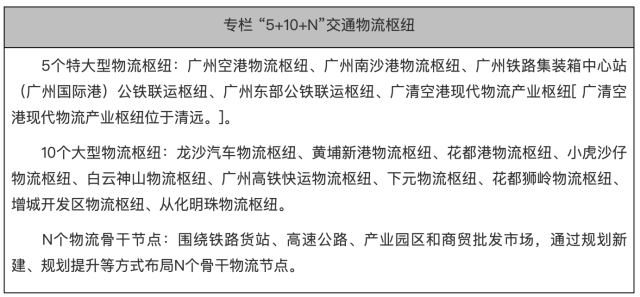
The concept of integrated development of station and city will promote the integrated development of major transportation infrastructure and the city. Taking advantage of the development of air-rail intermodal transport, Guangzhou will promote the development of the surrounding areas of Guangzhou Baiyun International Airport and Guangzhou North Railway Station, orderly promote the construction of regional transportation infrastructure along the air-rail avenue, and support the development of the northern growth pole. Strengthen the linkage between Nansha Port Area and Lingang Industrial Park, and promote the integrated development of port, industry and city.
Realize comprehensive development in and around railway stations, scientifically promote the comprehensive development and construction of railway hub station areas such as Guangzhou Railway Station, Guangzhou East Railway Station, Guangzhou International Port, Zengcheng West and other railway hub station areas and their surroundings, leverage urban renewal and urban village transformation in the area, promote industrial upgrading, improve functional quality, and promote the integration of stations and cities.
[Achievements in the construction of Guangzhou's comprehensive three-dimensional transportation network].
1. By the end of 2023, the total length of Guangzhou's comprehensive three-dimensional transportation network will exceed 16,000 kilometers, including 1,261 kilometers of rail (including 181 kilometers of high-speed rail, 318 kilometers of ordinary railway, 87 kilometers of intercity, and 675 kilometers of urban rail (including APM lines and trams)). With about 14,000 kilometers of roads and 1,481 kilometers of waterways, a transportation infrastructure network has been built to match that of megacities.
2. Guangzhou Baiyun International Airport will have a passenger throughput of 63.17 million passengers in 2023, ranking first in the country for four consecutive years, and a cargo and mail throughput of 2.03 million tons, ranking second in the country.
3. At present, Guangzhou Port has basically formed a port system with Nansha Port Area as the core, Huangpu Port Area and Xinsha Port Area as the focus, and Inner Harbor Port Area and Inland River Port as supplements. In 2023, the port's cargo and container throughput will reach 675 million tons and 25.41 million TEUs respectively, ranking fifth and sixth in the world, respectively.
4. In terms of railways, Guangzhou has built five high-speed railways, including Beijing-Wuhan-Guangzhou, Gui-Guangzhou, Nanguang, Guangzhou-Shenzhen-Hong Kong, and Guangzhou-Shantou, as well as six general-speed railways, including Beijing-Guangzhou, Guangzhou-Shenzhen, Guangzhou-Mao, Guangzhou-Zhuhai, and Guangzhou-Shishi railways (Guangzhou Northeast Freight Outer Winding Line) and Nansha Port Railway. The construction of Guangzhou International Port (Phase I) and the highway-rail intermodal transport hub in eastern Guangzhou began, and the level of road-rail and sea-rail intermodal transport has been continuously improved.
5. Eight railway passenger stations, including Guangzhou Railway Station, Guangzhou East Railway Station, Guangzhou South Railway Station, Guangzhou Baiyun Railway Station, Guangzhou North Railway Station, Xintang Railway Station, Qingsheng Railway Station and Zengcheng Railway Station, will be put into operation in 2023, with 131 million railway passengers in 2023, ranking second in the country, of which 91 million passengers will be sent by Guangzhou South Railway Station, ranking first in the country for many consecutive years. Guangzhou-Zhuhai Intercity, Guangzhou-Foshan-Zhaozhou Intercity, Guangqing Intercity, Guangzhou East Ring Intercity Airport Section, Guangzhou-Dongguan-Shenzhen Intercity have been put into operation to accelerate the construction of the "Greater Bay Area on the track".
6. In 2023, the speed of the evening peak trunk road in the core area will be 22.8 km/h, and the road operation will generally remain stable.
7. By the end of 2023, the operating mileage of urban rail (including APM lines and trams) will reach 675 kilometers [including 652.7 kilometers of subway and APM lines, including 619.4 kilometers in Guangzhou, 33.3 kilometers in Foshan, and 22.1 kilometers in trams], ranking third in the country in terms of operating mileage and passenger volume.
8. By the end of 2023, there will be 14,000 pure electric buses in the city, with a pure electric proportion of 98%.
9. By the end of 2023, a total of 797 ICV test roads have been opened, with a one-way mileage of 1,624 kilometers. The first batch of two high-speed test roads in the city were opened, with a one-way mileage of 105 kilometers, supporting Guangzhou to create a national Internet intelligent networked vehicle and intelligent transportation application demonstration zone.
Rail Transit Exhibition Booth Reservation
Rail Transit Exhibition Free registration for visit